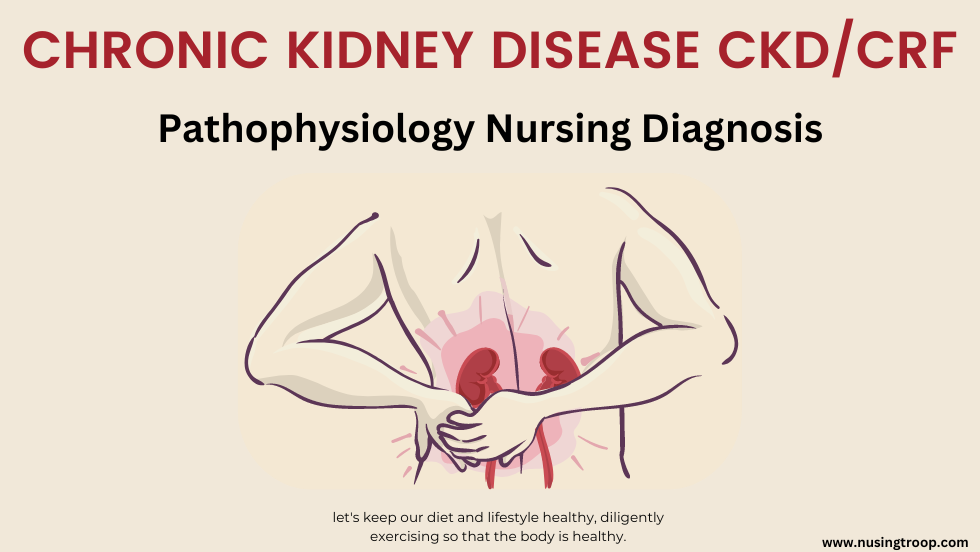Chronic Kidney Disease (CKD/CRF) is a severe condition that can lead to long-term health complications and even death. Nurses need the right tools and resources to properly diagnose, treat, and care for patients with CKD/CRF. Providing quality care without the proper training or knowledge can be challenging.
CKD/CRF Nursing Diagnosis & Care Plan provides nurses with comprehensive information on accurately diagnosing and developing an effective treatment plan for patients suffering from this disease. With our easy-to-use toolkit, nurses can confidently provide quality care while ensuring patient safety.
Table of Contents
What is Chronic Kidney Disease (CKD/CRF)?
Chronic Kidney Disease, also known as CKD or CRF, is a complex medical condition that affects millions of people worldwide. This disease occurs when the kidneys are damaged over a prolonged period, leading to a gradual decline in their function. While it can initially present with only mild symptoms, CKD can quickly progress to become a severe health issue.
Unfortunately, there is no known cure for this condition, but there are treatments and lifestyle changes that can help slow the progression of the disease and improve the patient’s quality of life.
The following risk factors increase the incidence of CRF:
- Diabetes mellitus
- Hypertension
- Overuse of drugs and medications, including nonsteroidal anti-inflammatory drugs (NSAIDs)
- Obstructive nephropathies such as Kidney Stones or Polycystic Kidney Disease
- Acute kidney injury resulting from toxin exposure or infection
- Glomerulonephritis and other forms of autoimmune diseases
- Chronic viral infections, such as HIV/AIDS or Hepatitis C
Stages of chronic kidney disease:
Stage 1 – GFR ≥ 90 mL/min/1.73 m2; no albuminuria or proteinuria
Stage 2 – GFR between 60 and 89 mL/min/1.73 m2; mild albuminuria or proteinuria
Stage 3 – GFR between 30 and 59 mL/min/1.73 m2; moderate to severe albuminuria or proteinuria
Stage 4 – GFR between 15 and 29 mL/min/1.73 m2; end-stage renal disease (ESRD) requiring dialysis, kidney transplantation, or both
Stage 5 – ESRD with a GFR ≤ 14 mL/min/1.73 m2
Pathophysiology of CKD
Chronic kidney disease (CKD) is characterized by a reduction in renal function which, if left unchecked, can progress to complete renal failure. Initially, the loss of function may not be apparent due to an adaptation of the remaining tissue allowing it to increase its performance.
As CKD progresses, the kidneys’ ability to maintain fluid and electrolyte homeostasis decreases, and they lose their capacity to concentrate or dilute urine. Glomerular filtration rate (GFR) falls below 15 mL/min/1.73 m2, and urine osmolality becomes fixed at around 300-320 mOsm/kg, close to that of plasma (275-295 mOsm/kg). Changes in water intake no longer produce a change in urine volume.
Creatinine and urea
When GFR starts to decline, the plasma concentrations of creatinine and urea (greatly influenced by glomerular filtration) rise gradually. However, these changes are subtle until the GFR falls below 15 mL/min/1.73 m2 (the average value is> 90 mL/min/1.73 m2). At this point, high levels of creatinine and urea are usually associated with systemic manifestations such as uremia.
It should be noted that these markers are not the primary cause of the uremic symptoms; instead, they indicate the presence of other unidentified substances which likely cause the symptoms.
Sodium and water
Despite a diminishing GFR, sodium and water balance is usually maintained due to increased fractional excretion of sodium in the urine and normal thirst response. However, heart failure can occur due to excessive or insufficient intake of either sodium or water.
Potassium
The renal system usually maintains plasma levels at normal until advanced kidney failure or overconsumption of potassium. Certain medications, such as potassium-sparing diuretics, ACE inhibitors, beta-blockers, NSAIDs, etc., can also raise potassium levels in people with less severe renal failure.
Calcium and phosphate
Abnormalities of calcium, parathyroid hormone (PTH), phosphate, and vitamin D metabolism may lead to renal osteodystrophy. Depleted production of calcitriol (vitamin D hormone) leads to hypocalcemia, whereas reduced phosphate excretion causes hyperphosphatemia. Secondary hyperparathyroidism is often seen at this stage.
pH and Bicarbonate
Renal failure usually leads to moderate metabolic acidosis (bicarbonate content 15-20 mmol/L). This can cause muscle wasting, bone loss, and accelerated kidney damage.
Anemia
Anemia is a common symptom of moderate to advanced CKD (stage 3 or above), with a hematocrit of 20-30% (35-40% in polycystic kidney disease). It is usually caused by insufficient erythropoietin production due to a reduction in functional renal mass, but other causes, such as iron, folate, and vitamin B12 deficiency, may also contribute.
Causes
Several different diseases and disorders, including diabetes, hypertension, glomerulonephritis, polycystic kidney disease, and acute renal failure, can cause CKD.
It is also seen in individuals with long-term use of certain medications or toxins such as lead or mercury.
The most common underlying cause of CKD is diabetes mellitus (DM). DM causes a progressive reduction in GFR resulting from microvascular changes in the kidneys, eventually leading to ESRD. Other risk factors for the development of CKD include a family history of kidney disease, age > 40 years, and obesity.
Nursing Management
The patient with ESRD requires competent nursing care to avoid the complications of reduced renal function and the stresses and anxieties of dealing with a life-threatening illness.
Nursing Assessment
Assessment of a patient with ESRD includes the following:
- Evaluation of fluid balance, electrolyte levels, and acid-base status
- Identification of signs and symptoms of infection, anemia, and malnutrition
- Assessment of psychosocial and spiritual needs
Nursing Diagnosis
- Risk for fluid volume deficit
- Risk for electrolyte imbalance
- Ineffective tissue perfusion related to decreased renal perfusion and filtration
- Anxiety or fear related to unknown prognosis
Nursing Interventions
Interventions include the following:
- Monitor fluid balance, intake, output, daily weight, and vital signs.
- Administer medications as prescribed.
- Encourage healthy lifestyle choices, including diet modifications, exercise, and abstinence from alcohol and illegal drugs.
- Provide education about dialysis therapy, treatments, and medications used to manage ESRD.
- Monitor the nutritional status of the patient.
- Encourage family support and involvement in care.
- Provide psychosocial support to reduce anxiety and fear.
- Refer patient and family to community resources for financial aid, transportation, home health care services, and other assistance.
How long a person with CKD can live?
A person’s age and sex largely determine life expectancy for kidney disease. For example, a 60-year-old man in stage 1 of kidney disease can expect to live approximately 15 years, while those in stages 2, 3, and 4 would have life expectancies of 13 years, 8 years, and 6 years respectively.
Conclusion
Chronic kidney disease is a developed condition that can lead to end-stage renal failure if left untreated. It is characterized by a gradual loss of renal function which can cause electrolyte imbalances, fluid volume deficits, anemia, infection, and malnutrition.
Treatment includes lifestyle modifications such as diet and exercise, medications, dialysis therapy, or transplantation when necessary. Nurses play an essential role in managing CKD patients by providing assessments, interventions, and education to promote healthy lifestyles, reduce anxiety and improve quality of life.
References
https://www.ncbi.nlm.nih.gov/books/NBK568778/
Mrs. Marie Brown has been a registered nurse for over 25 years. She began her nursing career at a Level I Trauma Center in downtown Chicago, Illinois. There she worked in the Emergency Department and on the Surgical Intensive Care Unit. After several years, she moved to the Midwest and continued her nursing career in a critical care setting. For the last 10 years of her nursing career, Mrs. Brown worked as a flight nurse with an air ambulance service. During this time, she cared for patients throughout the United States.

